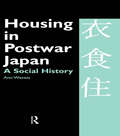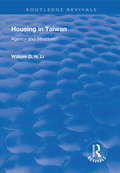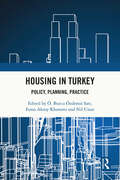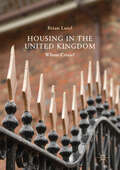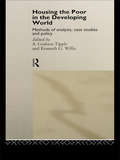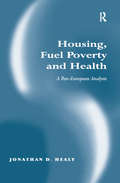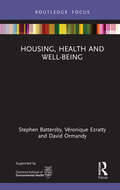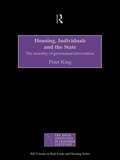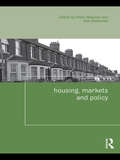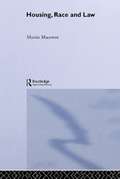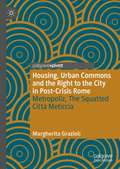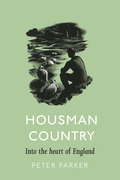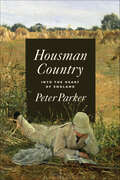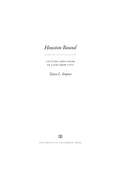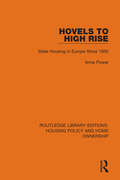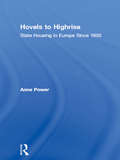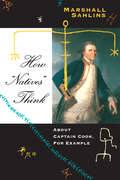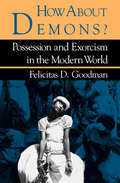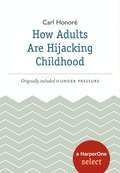- Table View
- List View
Housing in Postwar Japan - A Social History
by Ann WaswoRadical changes in the design of housing in post-war Japan had numerous effects on the Japanese people. Public policy toward housing provision and the effects of escalating land prices in Tokyo and a few other very large cities in the country from the mid- to late 1970s onward are examined, but it is dwellings themselves and the slow but steady shift from a floor-sitting to a chair-sitting housing culture in urban and suburban parts of the country that figure most prominently in the discussion. Central to the book is the author's translation of an account written by Kyoko Sasaki, an observant wife and mother, about the housing she and her growing family experienced during the 1960s, and subsequent chapters explore some of the issues that flow from her account. Chief among these are the small size and generally poor quality of the private-sector housing that Japanese of fairly ordinary means could afford to occupy in the early postwar years, the new design initiatives undertaken at about that time by public-sector housing providers and the diffusion of at least some of their initiatives to the housing sector as a whole, and the adjustments that the occupants of housing had to, or chose to, make as the dwellings available to them as renters or as owners changed in character. Attention is also paid to the structural requirements of dwellings and attitudes toward dwellings of diverse types in a country prone to earthquakes.
Housing in Taiwan: Agency and Structure? (Routledge Revivals)
by William D.H. LiPublished in 1998, in this book the author points out the inadequacies caused by the division between housing research on production and consumption, and the theoretical divide between structural and agent-centred approaches on housing. By developing an understanding of social relations within the structured process of housing provision, the author argues that action and the specific form of housing provision can be better understood. By using pre-sale housing in Taiwan as a positive example, the author shows how housing production and consumption are closely related and structured through agents' purposive interaction, and how agents are benefited through their relations.
Housing in Turkey: Policy, Planning, Practice
by Ö. Burcu Özdemir SarıThis book presents the major features of the path that Turkish housing system has followed since 2000. Its primary focus is to build an understanding of housing in Turkey from the policy, planning, and implementation perspectives in the 21st century, interwoven with the effects of neoliberalism. It investigates the social, spatial, and economic outcomes of the shift in philosophy and behaviour by the government regarding housing. The book discusses failures in housing outcomes as government failures, incorrect or inefficient regulations, lack of regulations, and lack of monitoring of the policy outcomes. Chapters on the housing-economy relationship, financialization and indebtedness, housing market experiences based on case studies, and the housing policy provide the reader with an opportunity to observe different outcomes in a world where housing challenges and issues are similar. This book will be of interest to urban planners, political scientists, and sociologists, as well as undergraduate/graduate students and housing sector experts all over the world who are interested in the various dimensions of the housing problem.
Housing in the United Kingdom: Whose Crisis?
by Brian LundIn this book, Brian Lund builds on contemporary housing crisis narratives, which tend to focus on the growth of a younger ‘generation rent,’ to include the differential effects of class, age, gender, ethnicity and place, across the United Kingdom. Current differences reflect long-established cleavages in UK society, and help to explain why housing crises persist. Placing the UK crises in their global contexts, Lund provides a critical examination of proposed solutions according to their impacts on different pathways through the housing system. As the first detailed analysis of the multifaceted origins, impact and potential solutions of the housing crisis, this book will be of vital interest to policy practitioners, professionals and academics across a wide range of areas, including housing studies, urban studies, geography, social policy, sociology, planning and politics.
Housing the Poor in the Developing World: Methods Of Analysis, Case Studies, And Policy
by Graham Tipple Kenneth G. TippleFirst Published in 2004. Routledge is an imprint of Taylor & Francis, an informa company.
Housing, Fuel Poverty and Health: A Pan-European Analysis
by Jonathan D. HealyThe first fully comparative study of fuel poverty across the EU, this work analyses the relationship between domestic energy efficiency, fuel poverty and health. The book adopts a holistic approach, incorporating a large number of social and economic risk factors to present a large-scale, cross-country, longitudinal analysis. The book is unique in: * Developing a new (consensual) methodology for calculating cross-country fuel poverty levels; * Presenting a detailed econometric/statistical analysis of EU fuel poverty; * Detailing the results of an empirical investigation of EU housing conditions, affordability and housing satisfaction; * Identifying risk factors related to seasonal variations in mortality across the EU; * Offering an empirical examination of health outcomes associated with fuel poverty; * Providing startling new evidence on fuel poverty in Southern Europe. Housing, Fuel Poverty and Health provides a powerful reference source for researchers and practitioners in the areas of energy economics, public health and epidemiology, housing and social policy.
Housing, Health and Well-Being (Routledge Focus on Environmental Health)
by Stephen Battersby Véronique Ezratty David OrmandyHousing is a social determinant of health and this book aims to provide a concise source of the theory and evidence on safe and healthy housing to inform students, academics, public and environmental health practitioners, and policy-makers, nationally and internationally. The book reviews the functions of housing and its relationship with the health and well-being of residents. It examines the implications of failures to satisfy those functions, including the potential impact on individuals, households, and society. It assesses options directed at avoiding, removing, or reducing threats and at promoting healthy indoor environments, particularly for the most susceptible and vulnerable members of society. It is essential reading for students, academics, and professionals within the areas of environmental health, public health, housing, built environment, social policy, housing policy, health policy, and law.
Housing, Homelessness, and Social Policy in the Urban North
by Julia Christensen Sally Carraher Travis Hedwig Steven ArnfjordHousing, Homelessness, and Social Policy in the Urban North brings together leading scholars on northern urban housing across the Canadian North, Alaska, and Greenland. Through various case studies, the contributors examine the ways in which housing insecurity and homelessness provide a critical lens on the social dimensions of northern urbanization. They also present key considerations in the development of effective and sustainable social policy for these areas. The book kickstarts a conversation between multiple stakeholders from different cultural and national regions across the North American north. It asks key questions including these: What are the common problems of, and responses to, housing insecurity and homelessness across these northern regions? Is a single definition of “homelessness” even possible, or desirable? And if not, can a shared language around how to end the housing crisis and homelessness in our northern regions still occur? The contributors explore how experiences of northern towns and cities inform an overall understanding of urban forms and processes in the contemporary world, and speak directly to the emerging body of literature on cities. Highlighting key limitations to federal, state, and provincial policy, Housing, Homelessness, and Social Policy in the Urban North raises important implications for developing policy that is responsive to northern realities.
Housing, Individuals and the State: The Morality of Government Intervention (Rics Issues In Real Estate And Housing Ser.)
by Peter KingCan the state solve housing problems or does it create them? This book explores the question by combining a detailed critique of contemporary housing policy with a philisophical analysis of the role of the state and individuals. Examining the state's role as controller and funder of housing, the author contends that the state is not capable of planning and controlling a sustainable housing policy.
Housing, Markets and Policy (Housing and Society Series)
by Peter Malpass Rob RowlandsThis book of specially commissioned essays by distinguished housing scholars addresses the big issues in contemporary debates about housing and housing policy in the UK. Setting out a distinctive and coherent analysis, it steers a course between those accounts that rely on economic theory and analysis and those that emphasize policy. It is informed by the idea that the 1970s was a pivotal decade in the second half of the twentieth century, and that since that time there has been a profound transformation in the housing system and housing policy in the UK. The contributors describe, analyze and explain aspects of that transformation, as a basis for understanding the present and thinking about the future. The analysis of housing is set within an understanding of the wider changes affecting the economy and the welfare state since the crises of the mid 1970s.
Housing, Race and Law: The British Experience
by Martin MacEwenEquality of opportunity in housing is a key issue in social justice in Britain today. To the extent that it patterns an individual's educational, social and economic development, housing constitutes a crucial battleground in the fight against racial discrimination. Housing, Race and Law is the first publication to examine the law in relation to issues of housing and race in both the private and public sector. It places these issues in the broader context of the development of anti-discrimination legislation, outlines the current legislation and examines its impact in relation to owner occupation, public housing, housing association tenancies and private lets. Throughout, the book emphasizes the practical impact of the various legislative provisions, and discusses the responses of the principle institutions from government departments and relevant professions to the Commission for Racial Equality and the Community Relations Councils (or Racial Equality Councils). It argues a case for a new approach to appraisal, review and enforcement. By collating material from a wide variety of sources, the author provides an original assessment of the Race Relations Act of 1976 and its impact on housing which, in its provision of cogent material and arguments for reforms, is designed to be of value to practitioners, academics and those concerned with racial discrimination.
Housing, Urban Commons and the Right to the City in Post-Crisis Rome: Metropoliz, The Squatted Città Meticcia
by Margherita GrazioliThis book tells the story of Metropoliz, a vacant salami factory located in the Eastern periphery of Rome (Italy) that was squatted in 2009 by homeless households with the cooperation of the Housing Rights Movement Blocchi Precari Metropolitani, and progressively reconverted into the house and museum spaces that form the Città Meticcia (the mestizo city). Through a vivid activist-ethnographic account, Margherita Grazioli suggests that Metropoliz exemplifies a practice of grassroots urban regeneration that speaks to the conflicted reconfiguration of real estate urban regimes in a post-crisis, post-neoliberal scenario. Using the contentious reappropriation of housing as a point of departure for claiming manifold rights, Metropoliz represents an alternative model of urbanity and habitation that will inspire contemporary urban social movements concerned with the demand of the ‘right to the city’, as well as those concerned with the ontology of the urban commons.
Housing: An Introduction
by Maureen Rhoden Paul BalchinHousing: The Essential Foundations provides a comprehensive introduction to housing studies. This topical text is essential reading for students embarking on degree and diploma courses in housing, surveying, town planning and other related subjects. Professionals within these fields will also find the book valuable as a source of up-to-date information and data. Uniquely multi-disciplinary and including a wealth of illustrations and examples, this book focuses on key topics which include: * equal opportunities and housing organisations * town planning and housing development * housing management, design and development * economics of housing * management and organisation * environmental health and housing * property, housing law, policy-making and politics * housing policy and finance prior to and post Thatcherism * future policy issues under the Labour government post 1997 Throughout the authors stress the importance of housing market activity that accords with good planning practice, legislation, democratic decision-making, economy and efficiency. In introducing the many diverse aspects of housing within a single volume, this book provides the essential foundations for the study of this multi-disciplinary subject. Paul Balchin, Gregory Bull, Pauline Forrester, David Isaac, R.Shean McConnell John O'Leary, Maureen Rhoden, Jane Weldon all at Univeristy of Greenwich, UK and Mark Pawlowski, University
Housman Country: Into the Heart of England
by Peter ParkerWhy is it that for many people 'England' has always meant an unspoilt rural landscape rather than the ever-changing urban world in which most English people live? What was the 'England' for which people fought in two world wars? What is about the English that makes them constantly hanker for a vanished past, so that nostalgia has become a national characteristic?In March 1896 a small volume of sixty-three poems was published by the small British firm of Kegan Paul, Trench, Trübner & Co. Ltd in an edition of 500 copies, priced at half-a-crown each. The author was not a professional poet, but a thirty-seven-year-old professor of Latin at University College, London called Alfred Edward Housman who had been obliged to pay £30 towards the cost of publication. Although slow to sell at first, A Shropshire Lad went on to become one of the most popular books of poetry ever published and has never been out of print. As well as being a publishing phenomenon, the book has had an influence on English culture and notions of what 'England' means, both in England itself and abroad, out of all proportion to its apparent scope. Housman Country will not only look at how A Shropshire Lad came to be written and became a publishing and cultural phenomenon, but will use the poems as a prism through which to examine England and Englishness. The book contains a full transcript of A Shropshire lad itself, also making it a superb present.
Housman Country: Into the Heart of England
by Peter ParkerWhy is it that for many people 'England' has always meant an unspoilt rural landscape rather than the ever-changing urban world in which most English people live? What was the 'England' for which people fought in two world wars? What is about the English that makes them constantly hanker for a vanished past, so that nostalgia has become a national characteristic?In March 1896 a small volume of sixty-three poems was published by the small British firm of Kegan Paul, Trench, Trübner & Co. Ltd in an edition of 500 copies, priced at half-a-crown each. The author was not a professional poet, but a thirty-seven-year-old professor of Latin at University College, London called Alfred Edward Housman who had been obliged to pay £30 towards the cost of publication. Although slow to sell at first, A Shropshire Lad went on to become one of the most popular books of poetry ever published and has never been out of print. As well as being a publishing phenomenon, the book has had an influence on English culture and notions of what 'England' means, both in England itself and abroad, out of all proportion to its apparent scope. Housman Country will not only look at how A Shropshire Lad came to be written and became a publishing and cultural phenomenon, but will use the poems as a prism through which to examine England and Englishness. The book contains a full transcript of A Shropshire lad itself, also making it a superb present.
Housman Country: Into the Heart of England
by Peter Parker“Parker’s beautiful Housman Country tells you everything you want to know about the life and influence of England’s most satirised but inimitable poets.” —Evening StandardA New York Times Book Review Editor’s ChoiceNominated for the 2017 PEN/Bograd Weld Prize for BiographyA. E. Housman’s A Shropshire Lad made little impression when it was first published in 1896 but has since become one of the best-loved volumes of poetry in the English language. Its evocation of the English countryside, thwarted love, and a yearning for things lost is as potent today as it was more than a century ago, and the book has never been out of print.In Housman Country, Peter Parker explores the lives of A. E. Housman and his most famous book, and in doing so shows how A Shropshire Lad has permeated English life and culture since its publication. The poems were taken to war by soldiers who wanted to carry England in their pockets, were adapted by composers trying to create a new kind of English music, and have influenced poetry, fiction, music, and drama right up to the present day. Everyone has a personal “land of lost content” with “blue remembered hills,” and Housman has been a tangible and far-reaching presence in a startling range of work, from the war poets and Ralph Vaughan Williams to Inspector Morse and Morrissey.Housman Country is a vivid exploration of England and Englishness, in which Parker maps out terrain that is as historical and emotional as it is topographical.“[A] rich blend of literary criticism and cultural history.” —The Spectator
Houston Bound
by Tyina SteptoeBeginning after World War I, Houston was transformed from a black-and-white frontier town into one of the most ethnically and racially diverse urban areas in the United States. Houston Bound draws on social and cultural history to show how, despite Anglo attempts to fix racial categories through Jim Crow laws, converging migrations--particularly those of Mexicans and Creoles--complicated ideas of blackness and whiteness and introduced different understandings about race. This migration history also uses music and sound to examine these racial complexities, tracing the emergence of Houston's blues and jazz scenes in the 1920s as well as the hybrid forms of these genres that arose when migrants forged shared social space and carved out new communities and politics. This interdisciplinary book provides both an innovative historiography about migration and immigration in the twentieth century and a critical examination of a city located in the former Confederacy.
Hovels to High Rise: State Housing in Europe Since 1850
by Anne PowerOriginally published in 1993, this book traces how governments in France, Germany, Britain, Denmark and Ireland became involved in replacing industrial revolution urban slums with mass high-rise, high-density concrete estates. As the book considers each country’s housing history and traditions, and analyses the contrasting structures and systems, it finds convergence of problems in the growing tensions of their most disadvantaged communities. The book underlines the continuing drift towards deeper polarization, an issue which has become ever more important in the multi-lingual, ethnically diverse urban societies of the 21st Century. The book’s detailed coverage of the historical, political and social changes relating to housing within the various countries make it an important text for students and practitioners concerned with housing, urban affairs, social policy and administration.
Hovels to Highrise: State Housing in Europe Since 1850
by Anne PowerHovels to Highrise traces how governments in five European countries became involved in replacing industrial revolution urban slums with mass high-rise, high density concrete estates. As the book considers each country's housing history and traditions, and analyses the contrasting structures and systems, it finds convergence of problems in the growing tensions of their most disadvantaged communities. Anne Power underlines the continuing drift towards deeper polarization, a problem that the European Community will not be able to ignore with the interlocking but multi-lingual, multi-ethnic, urban societies of the future. The book's detailed coverage of the historical, political amd social changes relating to housing within the various countries make it an important text for students and practitioners concerned with housing, urban affairs, social policy and administration.
How "Natives" Think: About Captain Cook, For Example
by Marshall SahlinsWhen Western scholars write about non-Western societies, do they inevitably perpetuate the myths of European imperialism? Can they ever articulate the meanings and logics of non-Western peoples? Who has the right to speak for whom? Questions such as these are among the most hotly debated in contemporary intellectual life. In How "Natives" Think, Marshall Sahlins addresses these issues head on, while building a powerful case for the ability of anthropologists working in the Western tradition to understand other cultures. In recent years, these questions have arisen in debates over the death and deification of Captain James Cook on Hawai'i Island in 1779. Did the Hawaiians truly receive Cook as a manifestation of their own god Lono? Or were they too pragmatic, too worldly-wise to accept the foreigner as a god? Moreover, can a "non-native" scholar give voice to a "native" point of view? In his 1992 book The Apotheosis of Captain Cook, Gananath Obeyesekere used this very issue to attack Sahlins's decades of scholarship on Hawaii. Accusing Sahlins of elementary mistakes of fact and logic, even of intentional distortion, Obeyesekere portrayed Sahlins as accepting a naive, enthnocentric idea of superiority of the white man over "natives"—Hawaiian and otherwise. Claiming that his own Sri Lankan heritage gave him privileged access to the Polynesian native perspective, Obeyesekere contended that Hawaiians were actually pragmatists too rational and sensible to mistake Cook for a god. Curiously then, as Sahlins shows, Obeyesekere turns eighteenth-century Hawaiians into twentieth-century modern Europeans, living up to the highest Western standards of "practical rationality." By contrast, Western scholars are turned into classic custom-bound "natives", endlessly repeating their ancestral traditions of the White man's superiority by insisting Cook was taken for a god. But this inverted ethnocentrism can only be supported, as Sahlins demonstrates, through wholesale fabrications of Hawaiian ethnography and history—not to mention Obeyesekere's sustained misrepresentations of Sahlins's own work. And in the end, although he claims to be speaking on behalf of the "natives," Obeyesekere, by substituting a home-made "rationality" for Hawaiian culture, systematically eliminates the voices of Hawaiian people from their own history.How "Natives" Think goes far beyond specialized debates about the alleged superiority of Western traditions. The culmination of Sahlins's ethnohistorical research on Hawaii, it is a reaffirmation for understanding difference.
How AI Is Transforming the Organization (The Digital Future of Management)
by MIT Sloan Management ReviewA clear-eyed look at how AI can complement (rather than eliminate) human jobs, with real-world examples from companies that range from Netflix to Walmart.Descriptions of AI's possible effects on businesses and their employees cycle between utopian hype and alarmist doomsaying. This book from MIT Sloan Management Review avoids both these extremes, providing instead a clear-eyed look at how AI can complement (rather than eliminate) human jobs, with real-world examples from companies that range from Netflix to Walmart. The contributors show that organizations can create business value with AI by cooperating with it rather than relinquishing control to it. The smartest companies know that they don't need AI that mimics humans because they already have access to resources with human capability—actual humans.The book acknowledges the prominent role of such leading technology companies as Facebook, Apple, Amazon, Netflix, and Google in applying AI to their businesses, but it goes beyond the FAANG cohort to look at AI applications in many nontechnology companies, including DHL and Fidelity. The chapters address such topics as retraining workers (who may be more ready for change than their companies are); the importance of motivated and knowledgeable leaders; the danger that AI will entrench less-than-ideal legacy processes; ways that AI could promote gender equality and diversity; AI and the global loneliness epidemic; and the benefits of robot–human collaboration. ContributorsCynthia M. Beath, Megan Beck, Joe Biron, Erik Brynjolfsson, Jacques Bughin, Rumman Chowdhury, Paul R. Daugherty, Thomas H. Davenport, Chris DeBrusk, Berkeley J. Dietvorst, Janet Foutty, James R. Freeland, R. Edward Freeman, Julian Friedland, Lynda Gratton, Francis Hintermann, Vivek Katyal, David Kiron, Frieda Klotz, Jonathan Lang, Barry Libert, Paul Michelman, Daniel Rock, Sam Ransbotham, Jeanne W. Ross, Eva Sage-Gavin, Chad Syverson, Monideepa Tarafdar, Gregory Unruh, Madhu Vazirani, H. James Wilson
How AI Thinks: How we built it, how it can help us, and how we can control it
by Nigel ToonTHE #2 TIMES BESTSELLER'Artificial intelligence is going to have a massive impact on everyone’s lives... an accessible and sensible read that helps demystify AI' Deborah Meaden, entrepreneur and star of Dragon's Den'Nigel Toon is a visionary leader in the field of artificial intelligence... a must-read' Marc Tremblay, Distinguished Engineer, MicrosoftThose who understand how AI thinks are about to win big.We are used to thinking of computers as being a step up from calculators - very good at storing information, and maybe even at playing a logical game like chess. But up to now they haven't been able to think in ways that are intuitive, or respond to questions as a human might. All that has changed, dramatically, in the past few years.Our search engines are becoming answer engines. Artificial intelligence is already revolutionising sectors from education to healthcare to the creative arts. But how does an AI understand sentiment or context? How does it play and win games that have an almost infinite number of moves? And how can we work with AI to produce insights and innovations that are beyond human capacity, from writing code in an instant to unfolding the elaborate 3D puzzles of proteins?We stand at the brink of a historic change that will disrupt society and at the same time create enormous opportunities for those who understand how AI thinks. Nigel Toon shows how we train AI to train itself, so that it can paint images that have never existed before or converse in any language. In doing so he reveals the strange and fascinating ways that humans think, too, as we learn how to live in a world shared by machine intelligences of our own creation.
How About Demons?: Possession and Exorcism in the Modern World (Folklore Today #No.467)
by Felicitas D. GoodmanThe author of the Exorcism of Anneliese Michel &“is to be commended for a stimulating and wide-reaching treatment of a compelling and much-debated subject&” (Journal of Folklore Research). As part of a series that strives to introduce new or previously unrecognized folkloric phenomena—as well as new approaches and theories that result from discovery and investigation—How About Demons? provides an overview of a topic that has for many years captured the imagination of people from all walks of life. Rich in detail derived from the author&’s fieldwork and anthropological literature, this work contemplates possession and exorcism in a holistic manner—discussing their effects on both the body and soul. How About Demons? paints a picture of possession as a usually positive experience occurring in a wide variety of cultures and religions around the globe. It also details the ritual of exorcism which is applied when things go wrong. &“Quite an interesting book.&”—Religious Studies Review &“It is by far superior to anything else on demons we have seen in the past few years.&”—The American Rationalist
How Adults Are Hijacking Childhood
by Carl HonoreThis selection from Carl Honore's Under Pressure explores the history of childhood, including social trends and cultural movements that have contributed to the current practice of hyperparenting. In How Adults Are Ruining Childhood bestselling author Carl Honore explores the contradictions inherent in modern parenting. We want children to strive for high-achieving adulthood while also enjoying a childhood full of joy and free of danger. We tell our children to "grow up" and then bristle when they do. We expect them to ful?ll our dreams and yet remain true to themselves. The common thread, of course, is that through the ages children have never chosen their own childhood. Adults have always called the tune. Today it seems to be more about the adults than ever.
How All Politics Became Reproductive Politics: From Welfare Reform to Foreclosure to Trump (Reproductive Justice: A New Vision for the 21st Century #2)
by Laura BriggsToday all politics are reproductive politics, argues esteemed feminist critic Laura Briggs. From longer work hours to the election of Donald Trump, our current political crisis is above all about reproduction. Households are where we face our economic realities as social safety nets get cut and wages decline. Briggs brilliantly outlines how politicians’ racist accounts of reproduction—stories of Black “welfare queens” and Latina “breeding machines"—were the leading wedge in the government and business disinvestment in families. With decreasing wages, rising McJobs, and no resources for family care, our households have grown ever more precarious over the past forty years in sharply race-and class-stratified ways. This crisis, argues Briggs, fuels all others—from immigration to gay marriage, anti-feminism to the rise of the Tea Party.
